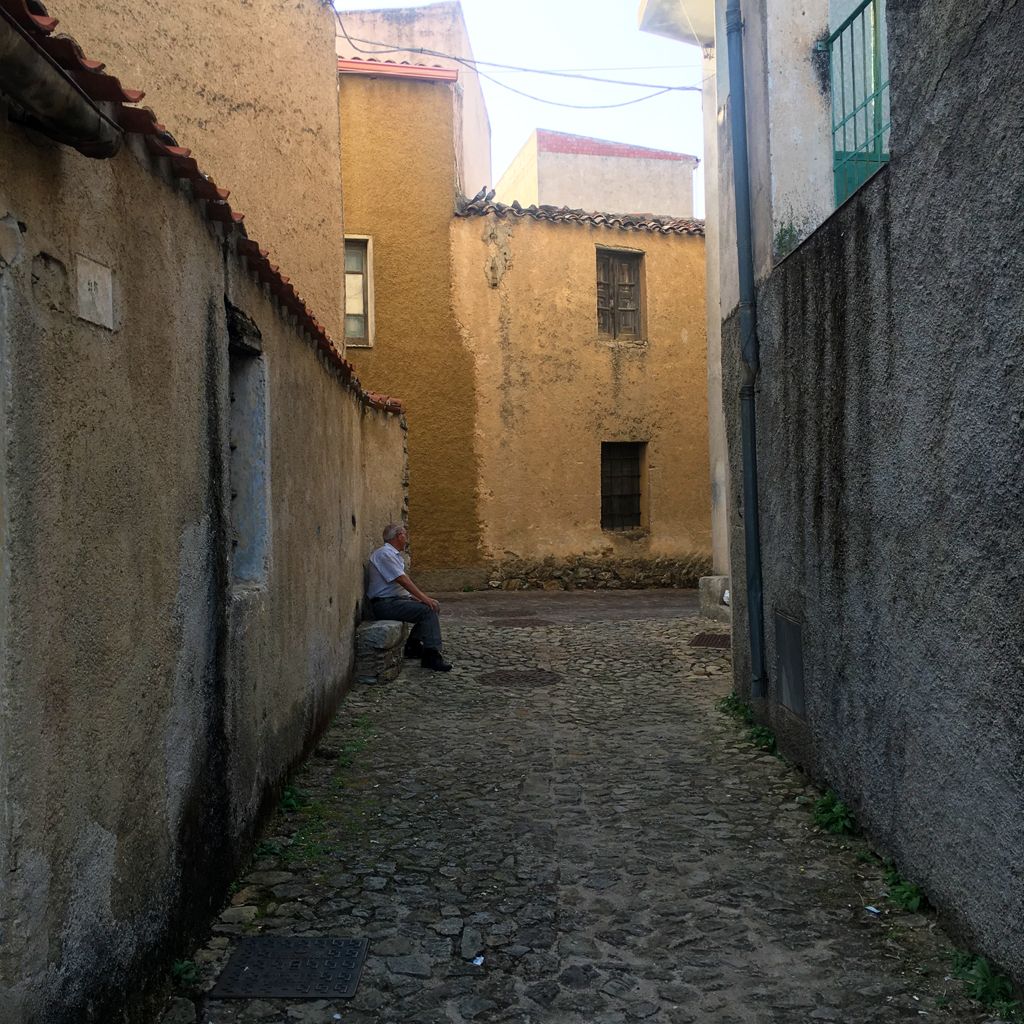
286/377: Meana Sardo
INSPIRATION

Today, after almost a year, I return to Barbagia. This portion of the territory has given me a hard time drawing the itinerary. And in fact today I will be forced to pass through Atzara, where I have already been on the twentieth day of the trip (266 days ago).
I start from Samugheo and after a nice descent that takes me to the bottom of the valley I begin the climb. It’s about 15 kilometers to Atzara, and another 10 of hard uphill to get to Meana Sardo, almost 700 meters in difference of altitude! I am halfway between Cagliari and Olbia, the “median” of the Romans, hence the name of the village. The mountains appear again and with them the greenery and the woods… and the climbs.
I arrive tired in the center where, outside the beautiful building of the Municipality, formerly Monte Granatico. Teresa is waiting for me. She has followed my journey from the beginning and today organised the day for me. It is already time for lunch and everything is ready on the table, where we eat together with Tzia Annamaria, Teresa’s mother, 93, all dressed in black and with a great desire to chat, in an almost Campidanese Sardinian that in Barbagia sounds a little strange.

After having recharged my energy thanks to a delicious glass of red wine produced by her winery Teresa takes me to Luigina, of the S’Andala Association, who will host me in the historic centre, in a beautiful house that has kept all the original features.
The days are getting shorter and take the opportunity to see as much as possible before dark. Reached by friend Efisia, we walk through the streets of the town, whose remaining historic houses are all built with schist, the predominant lithology here. Maybe as a geologist I know well the ages of all the rocks of Sardinia, and this very ancient Palaeozoic schist makes me think of an “archaic” world. The red trachytes of Samugheo are a distant memory.

In Piazza Fenu, where the eye immediately falls on an imposing mural by Mauro Patta, there are the few remains of the small church of San Sebastiano. We continue towards the church of Sant’Antonio Abate, the old parish church then rebuilt in the 1960s (using trachyte!) Outside, the saint is celebrated with the lighting of Su Fogadone, the bonfire on January 16.
We walk along stone streets, passing ancient portals, and we stop in front of a courtyard of an old house, where the owner X lets us in to admire the original environments, small rooms furnished as in the past, with everyday objects and utensils included.

We continue towards the outskirts of the town to visit the Funtana Manna, an ancient stone fountain of the sixteenth century, and immediately afterwards we reach the Funtanedda, a smaller fountain, which together with various wells scattered throughout the village supplied water to the inhabitants.

Returning towards the centre, amidst suggestive views of schist, Signora Giovanna, returning from mass wearing a traditional dark dress and a white handkerchief on her head, allows me to photograph her at the entrance to her beautiful home. We are in that portion of Sardinia where, now rare, some women still wear traditional clothes to go out. I had only seen it in Busachi, not very far from here.
For the last visit of the day we have to take the car. We travel through the countryside, between woods and important vineyards. The territory is in fact suited to viticulture, and in addition to the historical one of Teresa there are two other wineries that produce excellent Mandrolisai wine, obtained from Cannonau, Muristellu and Monica grapes.
Not far from here is the station Green Train of Ortuabis, on the Isili-Sorgono line. We go up to the hill where the imposing Nuraghe Nolza is located. Once again the nuragic architectures strike me with their perfection. This, which seems to be a real palace, still needs a lot of work to be fully brought to light, but you can already guess, from its four towers plus the central body, its majesty.

We go inside and climb to the top of a tower. The sun is setting in the glitter of the Gulf of Oristano and from up here the view is incredible. I feel master of these territories that I crossed with the strength of my legs and at the same time powerless in the face of the greatness of nature and of our past history.
SOUND FRAGMENTS
Return to Barbagia

SARDINIAN SHORT STORIES

Our evening in Meana ends in a pizzeria, where Francesco, Efisia’s companion and once president of the S’Andala association, to which Luigina, who’s hosting me today, also belongs. The association was created by Bartolomeo, Luigina’s brother who unfortunately passed away in 2001 at the age of 44, leaving a void not only among people but also in the cultural life of the village.
Bartolomeo loved this territory and his hometown, and the foundation of S’Andala meant for him to create “an ideal path of historical and sentimental memory, and research, in an era in which the removal of the past and self-forgetfulness prevail”.
His passion, in addition to the promotion and realisation of various cultural activities, guided him in the research of the history of Meana, and led him to the publication of the volume “Meana Sardo and the great transformation in the twentieth century” published by AM&D Edizioni.
Today the memory of Bartolomeo is kept alive by the association’s activities, which continue with the publication of books and videos, concerning research on the history of the Nuragic and Giudical Era, and in general on the memories of the town. And last but not least the support to my passage in this extreme corner of Barbagia. Thanks.